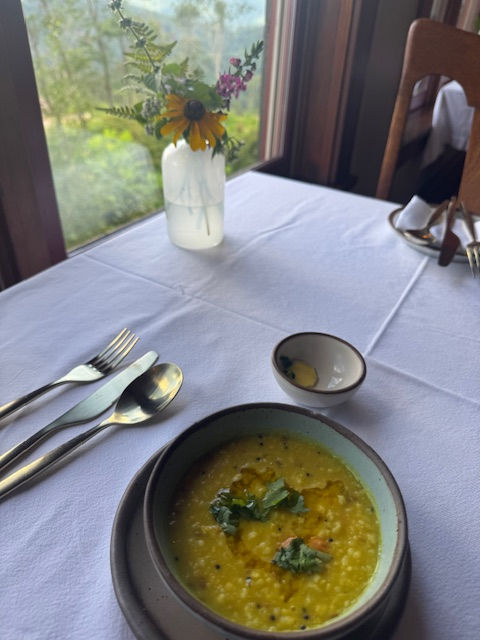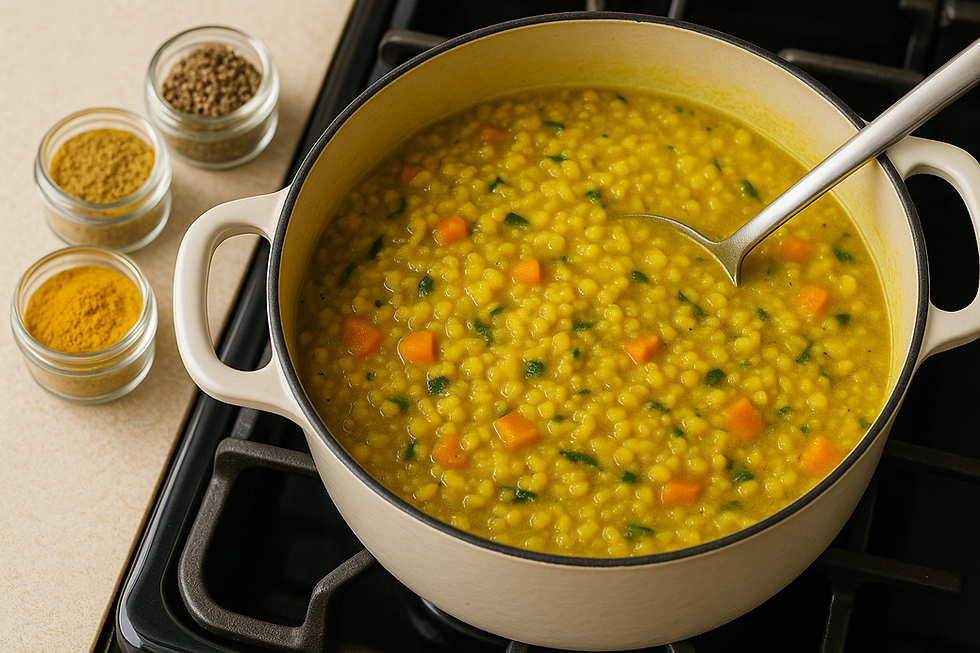Golden Kitchari: The Ayurvedic Comfort Food for Gentle Cleansing & Healing
- Rachel Canale
- 3 days ago
- 3 min read

If there’s one dish that embodies the heart of Ayurveda, it’s kitchari—a warm, nourishing blend of mung dal, rice, and digestive spices.And when you add turmeric’s golden glow, you get Golden Kitchari: the ultimate comfort food for body, mind, and spirit.
Whether you’re doing a seasonal reset, supporting digestion, or just craving something simple and soothing, this one-pot meal has your back.
What is Kitchari?
In Sanskrit, kitchari means “mixture,” and in Ayurveda it refers to a balanced combination of protein-rich mung dal and easy-to-digest rice, cooked with ghee and spices that stoke agni (digestive fire).
Kitchari is often used during:
Panchakarma or Ayurvedic cleansing programs
Seasonal transitions (spring and fall)
Recovery from illness
Times of stress or low energy
Because it’s light yet nourishing, kitchari allows the body to heal without the digestive strain of heavier meals.

Why “Golden” Kitchari?
The golden color comes from turmeric, Ayurveda’s most celebrated anti-inflammatory spice. Turmeric is known to:
Support liver function and detoxification
Boost immunity
Reduce inflammation in the joints and tissues
Promote radiant skin
When combined with cumin, coriander, fennel, and ginger, turmeric creates a synergy that boosts digestion while gently cleansing.
Golden Kitchari Recipe
Serves: 2-3 | Time: 45 minutes | Vegan & Gluten-Free
Ingredients:
½ cup split yellow mung dal (washed and soaked for 30 minutes)
½ cup white basmati rice (washed)
1 tbsp ghee or coconut oil
1 tsp cumin seeds
1 tsp ground coriander
1 tsp turmeric powder
½ tsp ground fennel
1 tsp grated fresh ginger (or ½ tsp dried)
4–5 cups water (for soupier texture, use 6 cups)
1 tsp sea salt (or to taste)
Fresh cilantro for garnish
Optional: seasonal vegetables (zucchini, carrots, spinach, sweet potato)

Instructions:
Heat ghee in a heavy-bottomed pot over medium heat.
Add cumin seeds; stir until aromatic (about 30 seconds).
Add ginger, turmeric, coriander, and fennel; stir to coat.
Stir in mung dal and rice, coating them in the spices.
Add water, bring to a boil, then reduce heat and simmer, covered, for 30–40 minutes, stirring occasionally.
Add vegetables in the last 15 minutes of cooking, if using.
Season with salt, garnish with cilantro, and serve warm.
Simple Adjustments for Your Needs
If you’re feeling scattered or depleted: Add a little extra ghee and include sweet, grounding vegetables like carrots, sweet potato, or zucchini.
If you’re running warm or easily irritated: Go lighter on the ginger and opt for cooling garnishes like fresh cilantro or a squeeze of lime.
If you’re feeling sluggish or heavy: Increase the warming spices (like ginger and black pepper) and load up on non-starchy vegetables, using less rice.
When to Eat Golden Kitchari
Golden kitchari is ideal when you want to:
Reset digestion after overindulgence
Support immunity during seasonal changes
Give your body a break from processed or heavy foods
Many people enjoy kitchari as part of a 3-day Ayurvedic reset, eating it for breakfast, lunch, and dinner with warm herbal teas in between.
Final Thoughts
Golden kitchari isn’t just food—it’s a healing ritual.It invites you to slow down, eat mindfully, and give your body the simple, clean fuel it needs to restore balance.

If you’d like a complete Ayurvedic seasonal reset plan with recipes, movement, and self-care practices, join me for my 7-Day Ayurvedic Restart—it’s the perfect way to step into fall feeling lighter, clearer, and more energized. Sign up for the newsletter to stay informed! Sign up here




Comments